Gigabyte C246-WU4 operation manual

C246-WU4
User's Manual
Rev. 1001
12ME-C246WU4-1001R
For more product details, please visit GIGABYTE's website.
To reduce the impacts on global warming, the packaging materials of this product are recyclable and reusable. GIGABYTE works with you to protect the environment.
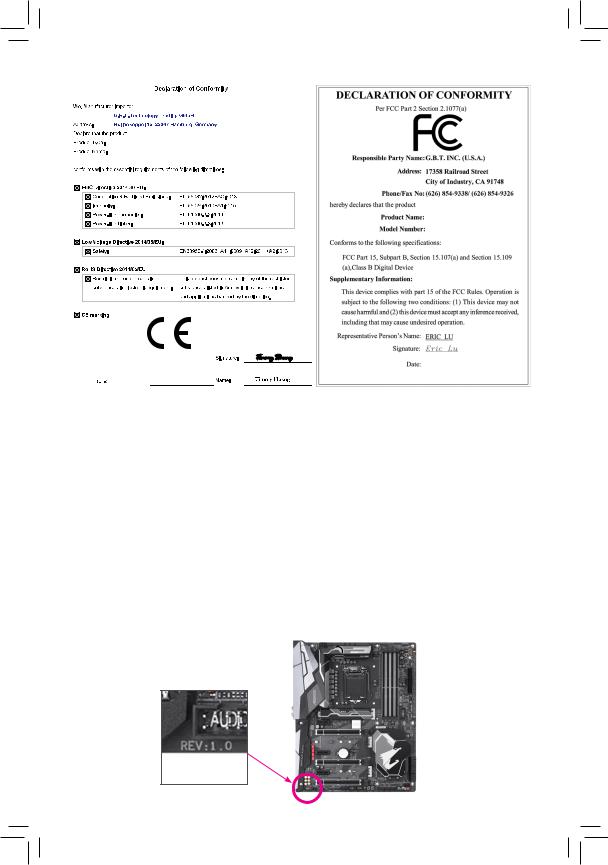
Motherboard
C246-WU4
Motherboard
C246-WU4
Oct. 19, 2018

 Oct. 19, 2018
Oct. 19, 2018
Copyright
© 2018 GIGA-BYTE TECHNOLOGY CO., LTD. All rights reserved.
The trademarks mentioned in this manual are legally registered to their respective owners.
Disclaimer
Information in this manual is protected by copyright laws and is the property of GIGABYTE.
ChangestothespecificationsandfeaturesinthismanualmaybemadebyGIGABYTEwithoutpriornotice.
No part of this manual may be reproduced, copied, translated, transmitted, or published in any form or by any means without GIGABYTE's prior written permission.
In order to assist in the use of this product, carefully read the User's Manual.
For product-related information, check on our website at: https://www.gigabyte.com
Identifying Your Motherboard Revision
The revision number on your motherboard looks like this: "REV: X.X." For example, "REV: 1.0" means the revision of the motherboard is 1.0. Check your motherboard revision before updating motherboard BIOS, drivers, or when looking for technical information.
Example:

Table of Contents
C246-WU4 Motherboard Layout...................................................................................... |
4 |
|
Chapter 1 Hardware Installation...................................................................................... |
5 |
|
1-1 |
Installation Precautions..................................................................................... |
5 |
1-2 |
Product Specifications...................................................................................... |
6 |
1-3 |
Installing the CPU............................................................................................. |
9 |
1-4 |
Installing the Memory........................................................................................ |
9 |
1-5 Installing an Expansion Card.......................................................................... |
10 |
|
1-6 Setting up AMD CrossFire™ Configuration...................................................... |
10 |
|
1-7 |
Back Panel Connectors.................................................................................. |
11 |
1-8 |
Internal Connectors........................................................................................ |
13 |
Chapter 2 BIOS Setup................................................................................................... |
24 |
|
2-1 |
Startup Screen................................................................................................ |
24 |
2-2 |
The Main Menu............................................................................................... |
25 |
2-3 |
M.I.T................................................................................................................ |
26 |
2-4 |
System............................................................................................................ |
33 |
2-5 |
BIOS............................................................................................................... |
34 |
2-6 |
Peripherals...................................................................................................... |
37 |
2-7 |
Chipset............................................................................................................ |
40 |
2-8 |
Power.............................................................................................................. |
41 |
2-9 |
Save & Exit..................................................................................................... |
43 |
Chapter 3 Appendix....................................................................................................... |
44 |
|
3-1 Configuring a RAID Set.................................................................................. |
44 |
|
3-2 Installing an Intel® Optane™ Memory.............................................................. |
46 |
|
3-3 |
Drivers Installation.......................................................................................... |
47 |
3-4 |
Debug LED Codes.......................................................................................... |
48 |
Regulatory Statements.............................................................................................. |
52 |
|
Contact Us................................................................................................................. |
56 |
|
- 3 -
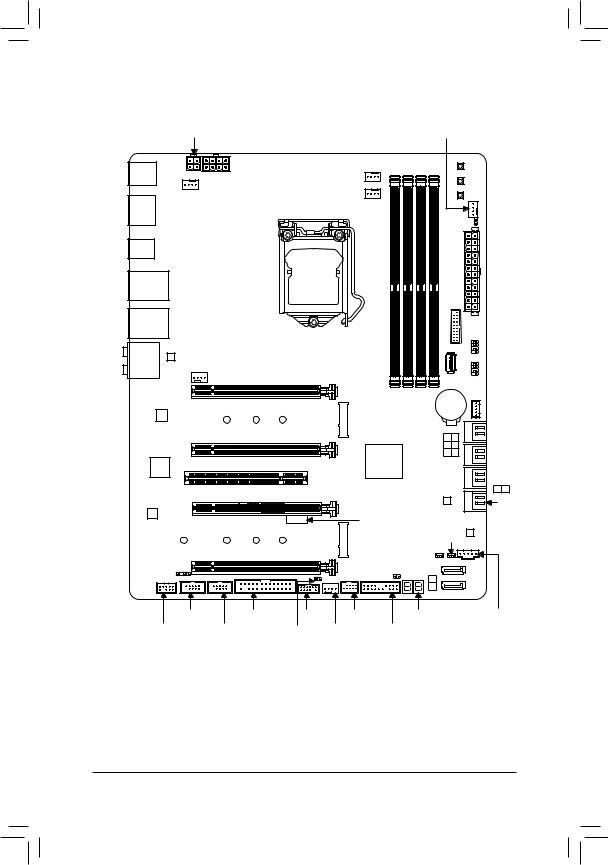
C246-WU4 Motherboard Layout
ATX_12V_2X2 |
SYS_FAN3_PUMP |
KB_MS_USB |
|
ATX_12V_2X4 |
CPU_FAN |
|
|
|
PW_SW |
|
|||
|
|
|
|
|
|
|
CMOS_SW |
||||
|
|
SYS_FAN1 |
|
|
|
|
|
||||
|
|
|
|
|
|
|
|
||||
|
|
|
|
CPU_OPT |
|
|
|
RST_SW |
|
||
|
|
|
|
|
|
|
|
|
|
||
DUAL_DP |
|
|
|
|
LGA1151 |
|
|
|
|
|
|
|
|
|
|
|
|
|
EC_TEMP2 |
|
|||
|
|
|
|
|
|
|
|
|
|
||
USB31 |
|
|
|
|
|
|
|
|
|
|
|
TYPEC |
|
|
|
|
|
|
|
|
ATX |
|
|
|
|
|
|
|
|
|
|
|
|
|
|
USB30_LAN2 |
|
|
|
|
|
|
|
|
|
|
|
USB30_LAN1 |
|
|
|
|
|
|
|
USB30F |
|
|
|
|
|
|
|
|
|
|
|
|
|
||
|
Intel® GbE |
|
|
|
|
|
|
OB |
SATA_SGP2 |
||
AUDIO |
|
|
|
|
|
|
|
|
|||
LAN |
|
|
C246-WU4 |
|
|
USB30 |
SATA_SGP1 |
||||
|
|
SYS_FAN2 |
|
|
|
||||||
|
|
|
|
|
|
|
|
|
|
||
Intel® |
GbE |
PCIEX16 |
|
|
|
|
A1 A2 B1 B2 |
|
|
|
|
LAN |
|
80 |
60 |
42 |
M2A |
DDR4 DDR4 |
DDR4 DDR4 |
BAT |
THB_C |
||
|
|
|
|
||||||||
|
|
|
|
|
|
|
|||||
|
|
PCIEX4_1 |
|
|
|
|
|
|
1 0 |
|
|
|
|
|
|
|
|
|
|
|
3 2 |
|
|
iTE® |
|
|
|
|
|
Intel® C246 |
|
5 4 |
|
|
|
|
PCI |
|
|
|
|
SATA3 |
|
|
|||
Super I/O |
|
|
|
|
|
|
|
|
|||
|
|
|
|
|
|
|
|
|
|||
|
|
|
|
|
|
|
|
|
|
|
1 0 |
CODEC |
|
PCIEX8 |
|
|
|
|
|
ASMedia® |
|
GSATA3 |
|
|
|
|
|
|
|
|
ASM1061 |
|
|||
|
|
|
|
|
|
|
|
|
|||
|
|
|
|
|
|
PCIe to PCI |
|
M_BIOS |
|
||
|
110 |
80 |
60 |
42 |
Bridge |
|
|
|
|||
|
M2M |
|
SATA_DOM0 |
|
|
||||||
|
|
|
|
|
|
|
|
|
|||
|
|
|
|
|
|
|
|
|
|
|
|
|
|
PCIEX4_2 |
|
|
|
|
SATA_DOM1 |
|
|
|
|
SPDIF_O |
|
|
|
|
CLR_CMOS |
SATA3 |
|
|
|||
|
|
|
|
|
|
6 |
|
|
|
||
|
|
|
|
|
|
|
|
|
|
|
|
|
|
|
|
|
|
|
|
7 |
|
|
|
|
|
COMA |
|
LPT |
TPM |
F_USB1 |
DB_PORT(Note) |
PMBUS |
|||
F_AUDIO |
COMB |
|
EC_TEMP1 |
SYS_FAN4_PUMP |
F_PANEL |
|
|
|
|
||
Box Contents |
|
|
|
|
|
|
|
|
|
|
|
55 C246-WU4 motherboard |
|
|
55 Six SATA cables |
|
|
|
|||||
55 Motherboard driver disk |
|
|
55 I/O Shield |
|
|
|
|
||||
55 User's Manual |
|
|
|
55 One G Connector |
|
|
|
||||
55 Two thermistors cables |
|
|
|
|
|
|
|
|
|||
*The box contents above are for reference only and the actual items shall depend on the product package you obtain. The box contents are subject to change without notice.
(Note) For debug code information, please refer to Chapter 3. - 4 -

Chapter 1 Hardware Installation
1-1 Installation Precautions
The motherboard contains numerous delicate electronic circuits and components which can become damaged as a result of electrostatic discharge (ESD). Prior to installation, carefully read the user's manual and follow these procedures:
•• Prior to installation, make sure the chassis is suitable for the motherboard.
•• Prior to installation, do not remove or break motherboard S/N (Serial Number) sticker or warranty sticker provided by your dealer. These stickers are required for warranty validation.
•• Always remove the AC power by unplugging the power cord from the power outlet before installing or removing the motherboard or other hardware components.
•• When connecting hardware components to the internal connectors on the motherboard, make sure they are connected tightly and securely.
•• When handling the motherboard, avoid touching any metal leads or connectors.
•• It is best to wear an electrostatic discharge (ESD) wrist strap when handling electronic components such as a motherboard, CPU or memory. If you do not have an ESD wrist strap, keep your hands dry and first touch a metal object to eliminate static electricity.
•• Prior to installing the motherboard, please have it on top of an antistatic pad or within an electrostatic shielding container.
•• Before connecting or unplugging the power supply cable from the motherboard, make sure the power supply has been turned off.
•• Before turning on the power, make sure the power supply voltage has been set according to the local voltage standard.
•• Before using the product, please verify that all cables and power connectors of your hardware components are connected.
•• To prevent damage to the motherboard, do not allow screws to come in contact with the motherboard circuit or its components.
•• Make sure there are no leftover screws or metal components placed on the motherboard or within the computer casing.
•• Do not place the computer system on an uneven surface.
•• Do not place the computer system in a high-temperature or wet environment.
•• Turning on the computer power during the installation process can lead to damage to system components as well as physical harm to the user.
•• If you are uncertain about any installation steps or have a problem related to the use of the product, please consult a certified computer technician.
•• If you use an adapter, extension power cable, or power strip, ensure to consult with its installation and/or grounding instructions.
- 5 -

1-2 Product Specifications
CPU |
LGA1151 package: |
|
- Intel® Xeon® E series processors |
-9th and 8th Generation Intel® Core™ processors/Intel® Pentium® processors/ Intel® Celeron® processors
(Go to GIGABYTE's website for the latest CPU support list.)L3 cache varies with CPU
Chipset |
|
Intel® C246 Express Chipset |
Memory |
|
4 x DDR4 DIMM sockets supporting up to 64 GB of system memory |
|
Dual channel memory architecture |
|
|
Support for DDR4 2666/2400/2133 MHz memory modules |
|
|
Support for ECC Un-buffered DIMM 1Rx8/2Rx8 memory modules |
|
|
Support for non-ECC Un-buffered DIMM 1Rx8/2Rx8/1Rx16 memory modules |
|
|
Support for Extreme Memory Profile (XMP) memory modules |
|
|
|
(Go to GIGABYTE's website for the latest supported memory speeds and memory |
|
|
modules.) |
Onboard |
|
Integrated Graphics Processor-Intel® UHD Graphics support: |
Graphics |
|
- 2 x DisplayPorts, supporting a maximum resolution of 4096x2304@60 Hz |
|
|
* Support for DisplayPort 1.2 version, HDCP 2.2, and HDR. |
|
Maximum shared memory of 1 GB |
|
Audio |
|
Realtek® ALC1220-VB codec |
|
|
* The back panel line out jack supports DSD audio. |
|
High Definition Audio |
|
|
|
2/4/5.1/7.1-channel |
|
Support for S/PDIF Out |
|
LAN |
|
2 x Intel® GbE LAN chips (10/100/1000 Mbit) |
Expansion Slots |
|
1 x PCI Express x16 slot, running at x16 (PCIEX16) |
|
|
* For optimum performance, if only one PCI Express graphics card is to be installed, |
|
|
be sure to install it in the PCIEX16 slot. |
|
1 x PCI Express x16 slot, running at x8 (PCIEX8) |
|
|
|
* The PCIEX8 slot shares bandwidth with the PCIEX16 slot. When the PCIEX8 slot |
|
|
is populated, the PCIEX16 slot operates at up to x8 mode. |
|
2 x PCI Express x16 slots, running at x4 (PCIEX4_1/PCIEX4_2) |
|
|
|
* The PCIEX4_2 slot shares bandwidth with the M2M connector. The PCIEX4_2 slot |
|
|
becomes unavailable when a PCIe SSD is installed in the M2M connector. |
|
|
(All of the PCI Express slots conform to PCI Express 3.0 standard.) |
|
1 x PCI slot |
|
Multi-Graphics |
Support for AMD Quad-GPU CrossFire™ and 3-Way/2-Way AMD CrossFire™ |
|
Technology |
|
technologies |
- 6 -

Storage |
|
Chipset: |
Interface |
|
- 1 x M.2 connector (Socket 3, M key, type 2242/2260/2280 SATA and PCIe |
|
|
x2 SSD support) (M2A) |
|
|
- 1 x M.2 connector (Socket 3, M key, type 2242/2260/2280/22110 PCIe x4/ |
|
|
x2 SSD support) (M2M) |
|
|
- 8 x SATA 6Gb/s connectors (SATA3 0~7) |
|
|
- Support for RAID 0, RAID 1, RAID 5, and RAID 10 |
|
|
* Refer to "1-8 Internal Connectors," for the installation notices for the PCIEX4_2, |
|
|
M.2 and SATA connectors. |
|
|
ASMedia® ASM1061 chip: |
|
|
- 2 x SATA 6Gb/s connectors (GSATA3 0~1), supporting AHCI mode only |
|
Intel® Optane™ Memory Ready |
|
USB |
|
Chipset: |
|
|
- 1 x USB Type-C™ port on the back panel, with USB 3.1 Gen 2 support |
|
|
- 1 x USB 3.1 Gen 2 Type-A port (red) on the back panel |
|
|
- 7 x USB 3.1 Gen 1 ports (4 ports on the back panel, 1 port onboard, 2 ports |
|
|
available through the internal USB header) |
|
|
- 4 x USB 2.0/1.1 ports (2 ports on the back panel, 2 ports available through |
|
|
the internal USB header) |
Internal |
|
1 x 24-pin ATX main power connector |
Connectors |
|
1 x 8-pin ATX 12V power connector |
1 x 4-pin ATX 12V power connector
1 x power information detection header2 x M.2 Socket 3 connectors
10 x SATA 6Gb/s connectors2 x SATA power headers
2 x SATA detection headers1 x CPU fan header
1 x water cooling CPU fan header2 x system fan headers
2 x system fan/water cooling pump headers1 x front panel header
1 x front panel audio header
1 x USB 3.1 Gen 1 port (USB30_OB)1 x USB 3.1 Gen 1 header
1 x USB 2.0/1.1 header1 x S/PDIF Out header
1 x Thunderbolt™ add-in card connector
1 x Trusted Platform Module (TPM) header (2x6 pin, for the GC-TPM2.0_S module only)
1 x parallel port header2 x serial port headers
2 x temperature sensor headers1 x power button
1 x reset button
1 x Clear CMOS button1 x Clear CMOS jumper
- 7 -
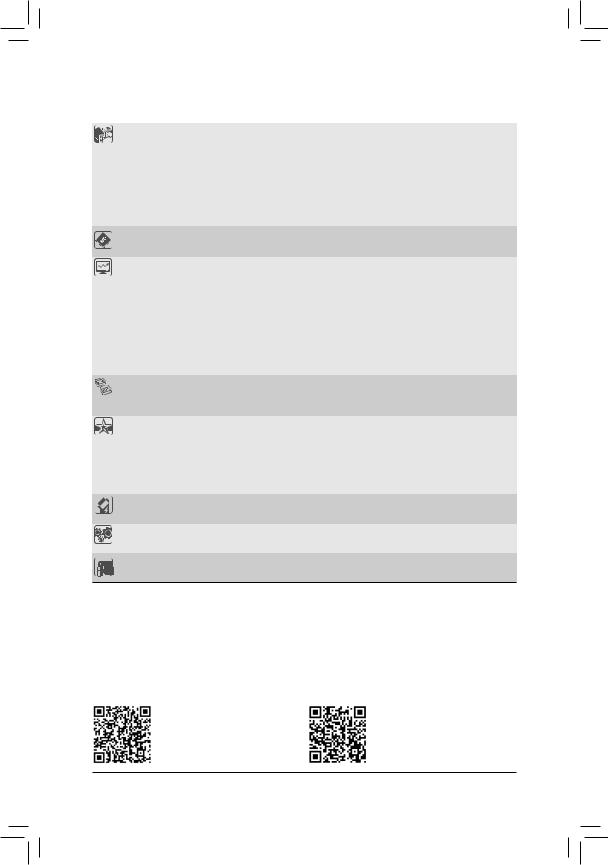
Back Panel |
|
1 x PS/2 keyboard/mouse port |
||
Connectors |
|
2 x DisplayPorts |
||
|
1 x USB Type-C™ port, with USB 3.1 Gen 2 support |
|||
|
1 x USB 3.1 Gen 2 Type-A port (red) |
|||
|
4 x USB 3.1 Gen 1 ports |
|||
|
2 x USB 2.0/1.1 ports |
|||
|
2 x RJ-45 ports |
|||
|
5 x audio jacks |
|||
I/O Controller |
|
iTE® I/O Controller Chip |
||
|
|
|
||
Hardware |
|
Voltage detection |
||
Monitor |
|
Temperature detection |
||
|
Fan speed detection |
|||
|
Water cooling flow rate detection |
|||
|
|
Overheating warning |
||
|
Fan fail warning |
|||
|
Fan speed control |
|||
|
|
|
* Whether the fan (pump) speed control function is supported will depend on the fan |
|
|
|
|
(pump) you install. |
|
BIOS |
|
1 x 128 Mbit flash |
||
|
Use of licensed AMI UEFI BIOS |
|||
|
PnP 1.0a, DMI 2.7, WfM 2.0, SM BIOS 2.7, ACPI 5.0 |
|||
Unique Features |
|
Support for APP Center |
||
|
|
|
* Available applications in APP Center may vary by motherboard model. Supported |
|
|
|
|
functionsofeachapplicationmayalsovarydependingonmotherboardspecifications. |
|
|
|
- |
@BIOS |
|
|
|
- |
System Information Viewer |
|
|
|
Support for Q-Flash |
||
Bundled |
|
Norton® Internet Security (OEM version) |
||
Software |
|
cFosSpeed |
||
Operating |
Support for Windows 10 64-bit |
|||
System |
||||
|
|
|
||
Form Factor |
|
ATX Form Factor; 30.5cm x 24.4cm |
||
*GIGABYTE reserves the right to make any changes to the product specifications and product-related information without prior notice.
Please visit GIGABYTE's website for support lists of CPU, memory modules, SSDs, and M.2 devices.
Please visit the Support\Utility List page on GIGABYTE's website to download the latest version of apps.
- 8 -

1-3 |
Installing the CPU |
|
|
Read the following guidelines before you begin to install the CPU: |
|
|
•• |
Make sure that the motherboard supports the CPU. |
|
|
(Go to GIGABYTE's website for the latest CPU support list.) |
|
•• |
Always turn off the computer and unplug the power cord from the power outlet before installing the |
|
•• |
CPU to prevent hardware damage. |
|
Locate the pin one of the CPU. The CPU cannot be inserted if oriented incorrectly. (Or you may |
|
|
•• |
locate the notches on both sides of the CPU and alignment keys on the CPU socket.) |
|
Apply an even and thin layer of thermal grease on the surface of the CPU. |
|
|
•• |
Do not turn on the computer if the CPU cooler is not installed, otherwise overheating and damage |
|
•• |
of the CPU may occur. |
|
Set the CPU host frequency in accordance with the CPU specifications. It is not recommended |
|
|
|
that the system bus frequency be set beyond hardware specifications since it does not meet the |
|
|
standard requirements for the peripherals. If you wish to set the frequency beyond the standard |
|
|
specifications, please do so according to your hardware specifications including the CPU, graphics |
|
|
card, memory, hard drive, etc. |
Installing the CPU
Locate the alignment keys on the motherboard CPU socket and the notches on the CPU.
LGA1151 CPU Socket |
|
|
LGA1151 CPU |
Alignment Key |
Alignment Key |
Notch |
Notch |
Pin One Corner of the CPU Socket |
Triangle Pin One Marking on the CPU |
Do not remove the CPU socket cover before inserting the CPU. It may pop off from the load plate automatically during the process of re-engaging the lever after you insert the CPU.
1-4 Installing the Memory
Read the following guidelines before you begin to install the memory:
•• Make sure that the motherboard supports the memory. It is recommended that memory of the same capacity, brand, speed, and chips be used.
(Go to GIGABYTE's website for the latest supported memory speeds and memory modules.)
•• Always turn off the computer and unplug the power cord from the power outlet before installing the memory to prevent hardware damage.
•• Memory modules have a foolproof design. A memory module can be installed in only one direction. If you are unable to insert the memory, switch the direction.
Dual Channel Memory Configuration
This motherboard provides four memory sockets and supports Dual Channel Technology. After the memory is installed, the BIOS will automatically detect the specifications and capacity of the memory. Enabling Dual
Channel memory mode will double the original memory bandwidth.
The four memory sockets are divided into two channels and each channel has two memory sockets as following:
Channel A: DDR4_A1, DDR4_A2Channel B: DDR4_B1, DDR4_B2
Please visit GIGABYTE's website for details on hardware installation.
- 9 -
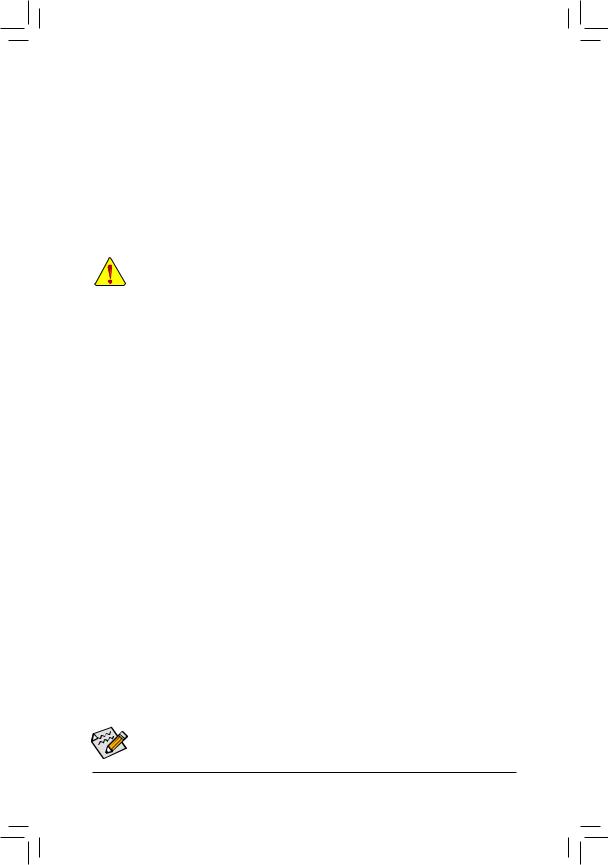
Dual Channel Memory Configurations Table
|
DDR4_A1 |
DDR4_A2 |
DDR4_B1 |
DDR4_B2 |
2 Modules |
- - |
DS/SS |
- - |
DS/SS |
|
DS/SS |
- - |
DS/SS |
- - |
4 Modules |
DS/SS |
DS/SS |
DS/SS |
DS/SS |
(SS=Single-Sided, DS=Double-Sided, "- -"=No Memory)
Due to CPU limitations, read the following guidelines before installing the memory in Dual Channel mode.
1.Dual Channel mode cannot be enabled if only one memory module is installed.
2.When enabling Dual Channel mode with two or four memory modules, it is recommended that memory of the same capacity, brand, speed, and chips be used.
1-5 Installing an Expansion Card
Read the following guidelines before you begin to install an expansion card:
•• Make sure the motherboard supports the expansion card. Carefully read the manual that came with your expansion card.
•• Always turn off the computer and unplug the power cord from the power outlet before installing an expansion card to prevent hardware damage.
1-6 Setting up AMD CrossFire™ Configuration
A.System Requirements
-- Windows 10 64-bit operating system
-- A CrossFire-supported motherboard with two or more PCI Express x16 slots and correct driver -- CrossFire-ready graphics cards of identical brand and chip and correct driver
(For the latest GPUs that support the 3-way CrossFire technology, please refer to the AMD website.) (Note 1) -- CrossFire (Note 2) bridge connectors
-- A power supply with sufficient power is recommended (Refer to the manual of your graphics cards for the power requirement)
B.Connecting the Graphics Cards
Step 1:
Install CrossFire graphics cards on the PCI Express x16 slots. (To set up a 2-Way configuration, we recommend installing the graphics cards on the PCIEX16 and PCIEX8 slots.)
Step 2:
Insert the CrossFire (Note 2) bridge connectors in the CrossFire gold edge connectors on top of the cards. Step 3:
Plug the display cable into the graphics card on the PCIEX16 slot.
C. Configuring the Graphics Card Driver
To Enable CrossFire Function
After installing the graphics card driver in the operating system, go to the AMD RADEON SETTINGS screen. Browse to Gaming\Global Settings and ensure AMD CrossFire is set to On.
(Note 1) When using dual core graphics cards, only 2-way is supported.
(Note 2) The bridge connector(s) may be needed or not depending on your graphics cards.
Procedure and driver screen for enabling CrossFire technology may differ by graphics cards and driver version.
Refer to the manual that came with your graphics cards for more information about enabling CrossFire technology.
- 10 -

1-7 Back Panel Connectors
 USB 2.0/1.1 Port
USB 2.0/1.1 Port
The USB port supports the USB 2.0/1.1 specification. Use this port for USB devices.
 PS/2 Keyboard/Mouse Port
PS/2 Keyboard/Mouse Port
Use this port to connect a PS/2 mouse or keyboard.
DisplayPort
DisplayPort delivers high quality digital imaging and audio, supporting bi-directional audio transmission. DisplayPort can support both DPCP and HDCP 2.2 content protection mechanisms. It provides improved visuals supporting Rec. 2020 (Wide Color Gamut) and High Dynamic Range (HDR) for Blu-ray UHD playback. You can use this port to connect your DisplayPort-supported monitor. Note: The DisplayPort
Technology can support a maximum resolution of 4096x2304@60 Hz but the actual resolutions supported depend on the monitor being used.
After installing the DisplayPort device, make sure to set the default sound playback device to DisplayPort. (The item name may differ depending on your operating system.)
 USB 3.1 Gen 2 Type-A Port (Red)
USB 3.1 Gen 2 Type-A Port (Red)
The USB 3.1 Gen 2 Type-A port supports the USB 3.1 Gen 2 specification and is compatible to the USB 3.1 Gen 1 and USB 2.0 specification. Use this port for USB devices.
USB Type-C™ Port
The reversible USB port supports the USB 3.1 Gen 2 specification and is compatible to the USB 3.1 Gen 1 and USB 2.0 specification. Use this port for USB devices.
 RJ-45 LAN Port
RJ-45 LAN Port
The Gigabit Ethernet LAN port provides Internet connection at up to 1 Gbps data rate. The following describes the states of the LAN port LEDs.
Connection/ |
|
|
|
|
|
|
|
|
Connection/Speed LED: |
Activity LED: |
|
||||||||
Speed LED |
|
|
|
Activity LED |
|
||||||||||||||
|
|
|
|
|
|
|
|
||||||||||||
|
|
|
|
|
|
|
|
|
|
|
|
|
|
|
State |
Description |
|
State |
Description |
|
|
|
|
|
|
|
|
|
|
|
|
|
|
|
Orange |
1 Gbps data rate |
|
Blinking |
Data transmission or receiving is occurring |
|
|
|
|
|
|
|
|
|
|
|
|
|
|
|
Green |
100 Mbps data rate |
|
On |
No data transmission or receiving is occurring |
|
|
|
|
|
|
|
|
|
|
|
|
|
|
|
|||||
|
|
|
|
|
|
|
|
|
|
|
|
|
|
|
Off |
10 Mbps data rate |
|
|
|
|
|
|
|
|
|
|
|
|
|
|
|
|
|
|
|
|
|
||
|
|
|
|
LAN Port |
|
|
|
||||||||||||
|
|
|
|
|
|
|
|
|
|||||||||||
 USB 3.1 Gen 1 Port
USB 3.1 Gen 1 Port
The USB 3.1 Gen 1 port supports the USB 3.1 Gen 1 specification and is compatible to the USB 2.0 specification. Use this port for USB devices.
 Center/Subwoofer Speaker Out (Orange)
Center/Subwoofer Speaker Out (Orange)
Use this audio jack to connect center/subwoofer speakers.
 Rear Speaker Out (Black)
Rear Speaker Out (Black)
Use this audio jack to connect rear speakers.
 Optical S/PDIF Out Connector
Optical S/PDIF Out Connector
This connector provides digital audio out to an external audio system that supports digital optical audio. Before using this feature, ensure that your audio system provides an optical digital audio in connector.
- 11 -
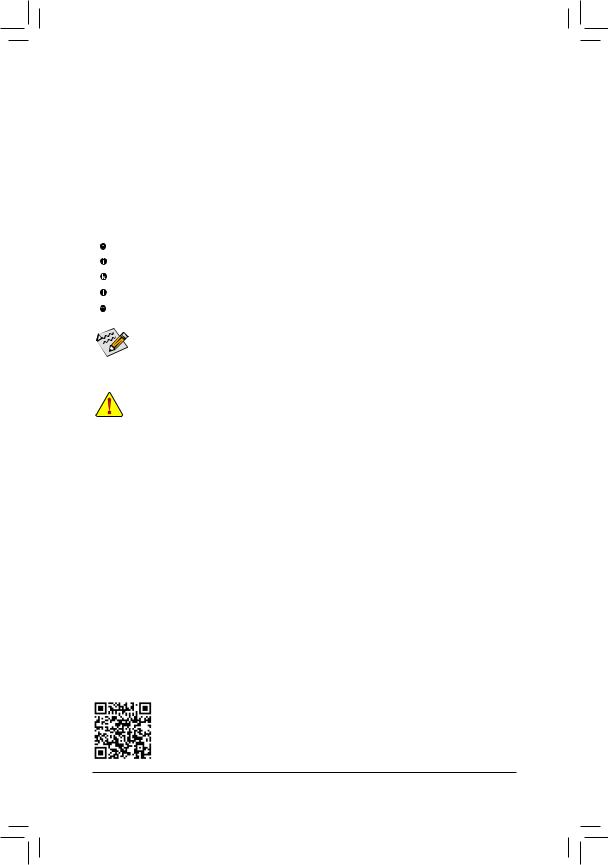
 Line In/Side Speaker Out (Blue)
Line In/Side Speaker Out (Blue)
The line in jack. Use this audio jack for line in devices such as an optical drive, walkman, etc.
 Line Out/Front Speaker Out (Green)
Line Out/Front Speaker Out (Green)
The line out jack. This jack supports audio amplifying function. For better sound quality, it is recommended that you connect your headphone/speaker to this jack (actual effects may vary by the device being used).
 Mic In/Side Speaker Out (Pink)
Mic In/Side Speaker Out (Pink)
The Mic in jack.
Audio Jack Configurations:
Jack |
Headphone/ |
4-channel |
5.1-channel |
7.1-channel |
|
2-channel |
|||||
|
|
|
|
||
Center/Subwoofer Speaker Out |
|
|
a |
a |
|
Rear Speaker Out |
|
a |
a |
a |
|
Line In/Side Speaker Out |
|
|
|
a |
|
Line Out/Front Speaker Out |
a |
a |
a |
a |
|
|
|
|
|
|
|
Mic In/Side Speaker Out |
|
|
|
a |
•• If you want to install a Side Speaker, you need to retask either the Line in or Mic in jack to be Side Speaker out through the audio driver.
•• To enable or configure the audio amplifying function for the Line out jack, please access the HD
Audio Manager application.
•• When removing the cable connected to a back panel connector, first remove the cable from your device and then remove it from the motherboard.
•• When removing the cable, pull it straight out from the connector. Do not rock it side to side to prevent an electrical short inside the cable connector.
Please visit GIGABYTE's website for details on configuring the audio software.
- 12 -
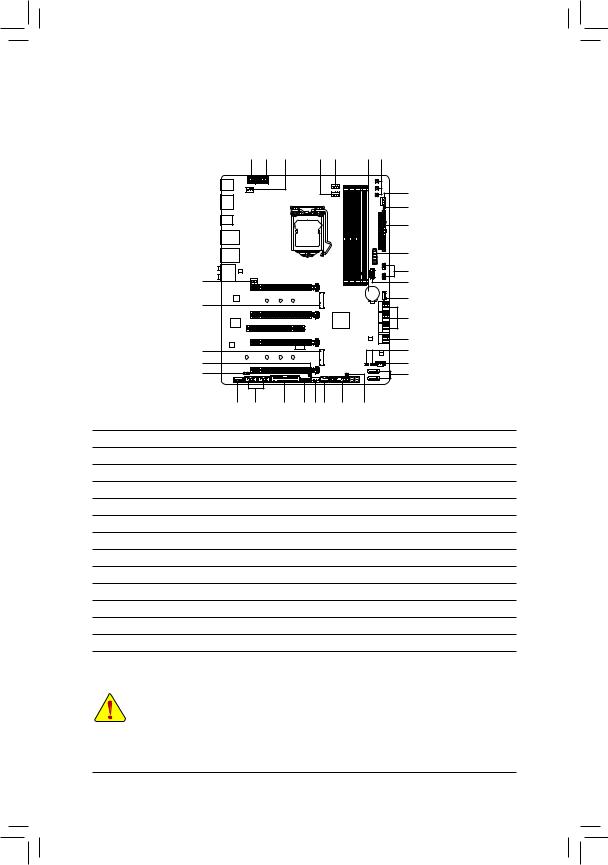
1-8 |
Internal Connectors |
|
|
|
|
|
|
|
|
|
|
1 |
1 |
5 |
7 |
4 |
|
24 |
26 |
|
|
|
|
|
|
|
|
|
6 |
|
|
|
|
|
|
|
|
|
8 |
|
|
|
|
|
|
|
|
|
2 |
|
|
|
|
|
|
|
|
|
18 |
|
5 |
|
|
|
|
|
|
|
12 |
|
|
|
|
|
|
|
|
17 |
|
|
13 |
|
|
|
|
|
|
|
20 |
|
|
|
|
|
|
|
|
9 |
|
|
|
|
|
|
|
|
|
|
|
|
13 |
|
|
|
|
|
|
|
10 |
|
|
|
|
|
|
|
|
11 |
|
|
8 |
|
|
|
|
|
|
|
3 |
|
16 |
|
|
|
|
|
|
|
9 |
|
15 |
23 |
|
22 |
21 6 19 |
|
14 |
25 |
|
1) |
ATX_12V_2X2/ATX_12V_2X4 |
|
|
14) |
|
F_PANEL |
|||
2) |
ATX |
|
|
|
15) |
|
F_AUDIO |
||
3) |
PMBUS |
|
|
|
16) |
|
SPDIF_O |
||
4) |
CPU_FAN |
|
|
|
17) |
|
USB30_OB |
||
5) |
SYS_FAN1/2 |
|
|
|
18) |
|
F_USB30 |
||
6) |
SYS_FAN3_PUMP/SYS_FAN4_PUMP |
19) |
|
F_USB1 |
|
||||
7) |
CPU_OPT |
|
|
|
20) |
|
THB_C |
|
|
8) |
EC_TEMP1/EC_TEMP2 |
|
|
|
21) |
|
TPM |
|
|
9) |
SATA3 0/1/2/3/4/5/6/7 |
|
|
|
22) |
|
LPT |
|
|
10) |
GSATA3 0/1 |
|
|
|
23) |
|
COMA/COMB |
||
11) |
SATA_DOM0/1 |
|
|
|
24) |
|
BAT |
|
|
12) |
SATA_SGP1/2 |
|
|
|
25) |
|
CLR_CMOS |
||
13) |
M2A/M2M |
|
|
|
26) |
|
PW_SW/CMOS_SW/RST_SW |
||
Read the following guidelines before connecting external devices:
•• First make sure your devices are compliant with the connectors you wish to connect.
•• Before installing the devices, be sure to turn off the devices and your computer. Unplug the power cord from the power outlet to prevent damage to the devices.
•• After installing the device and before turning on the computer, make sure the device cable has been securely attached to the connector on the motherboard.
- 13 -
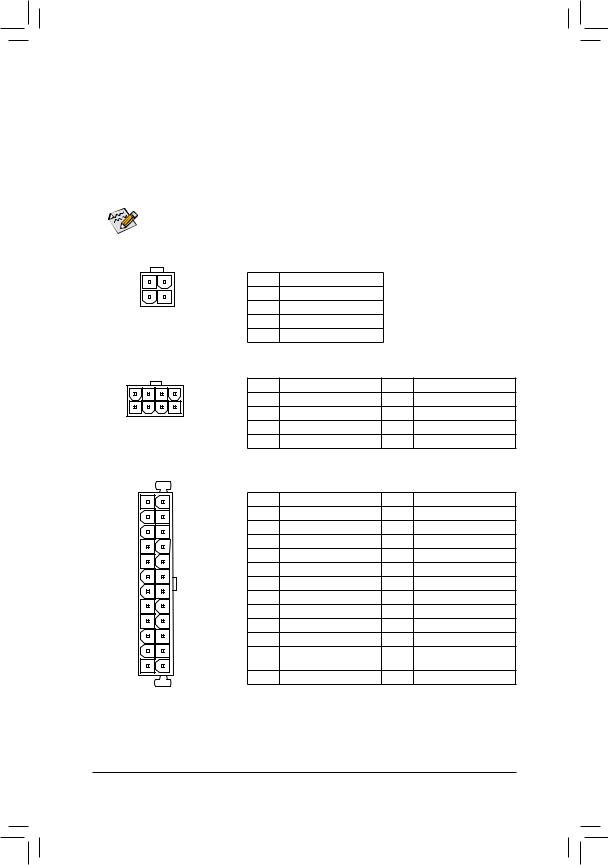
1/2)ATX_12V_2X2/ATX_12V_2X4/ATX (2x2, 2x4, 12V Power Connectors and 2x12 Main
Power Connector)
With the use of the power connector, the power supply can supply enough stable power to all the components on the motherboard. Before connecting the power connector, first make sure the power supply is turned off and all devices are properly installed. The power connector possesses a foolproof design. Connect the power supply cable to the power connector in the correct orientation.
The 12V power connector mainly supplies power to the CPU. If the 12V power connector is not connected, the computer will not start.
To meet expansion requirements, it is recommended that a power supply that can withstand high power consumption be used (500W or greater). If a power supply is used that does not provide the required power, the result can lead to an unstable or unbootable system.
34
12
ATX_12V_2X2
5 |
8 |
1 |
4 |
|
ATX_12V_2X4 |
12 24
1 |
13 |
ATX
ATX_12V_2X2:
Pin No. Definition
1GND
2GND
3+12V
4+12V
ATX_12V_2X4: |
|
|
|
Pin No. |
Definition |
Pin No. |
Definition |
1 |
GND (Only for 2x4-pin 12V) |
5 |
+12V (Only for 2x4-pin 12V) |
2 |
GND (Only for 2x4-pin 12V) |
6 |
+12V (Only for 2x4-pin 12V) |
3 |
GND |
7 |
+12V |
4 |
GND |
8 |
+12V |
ATX: |
|
|
|
Pin No. |
Definition |
Pin No. |
Definition |
1 |
3.3V |
13 |
3.3V |
2 |
3.3V |
14 |
-12V |
3 |
GND |
15 |
GND |
4 |
+5V |
16 |
PS_ON (soft On/Off) |
5 |
GND |
17 |
GND |
6 |
+5V |
18 |
GND |
7 |
GND |
19 |
GND |
8 |
Power Good |
20 |
NC |
9 |
5VSB (stand by +5V) |
21 |
+5V |
10 |
+12V |
22 |
+5V |
11 |
+12V (Only for 2x12-pin |
23 |
+5V (Only for 2x12-pin ATX) |
|
ATX) |
|
|
12 |
3.3V (Only for 2x12-pin ATX) |
24 |
GND (Only for 2x12-pin ATX) |
- 14 -
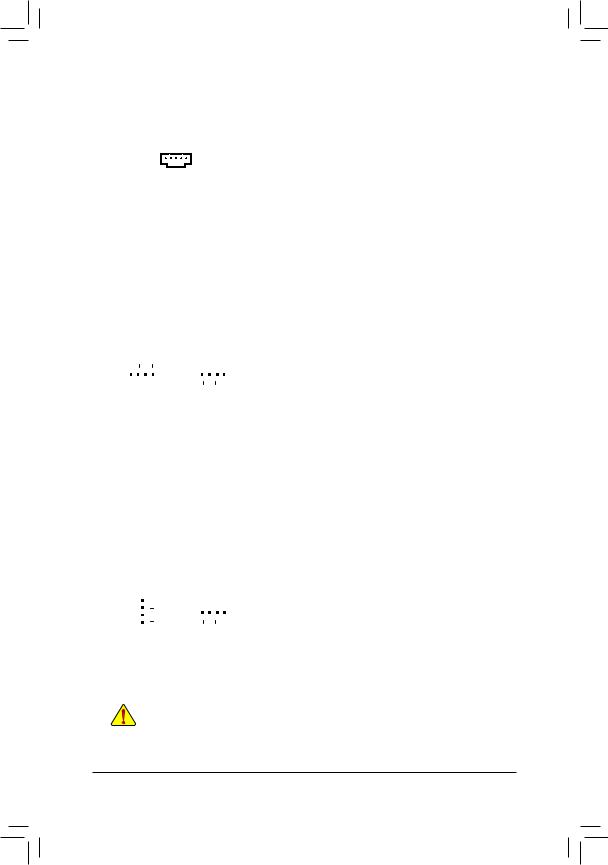
3)PMBUS (Power Information Detection Header)
The header allows for detection of the power information which can be displayed via the system software.
|
|
Pin No. |
Definition |
1 |
5 |
1 |
PMBUS_CLOCK |
|
|
2 |
PMBUS_DATA |
|
|
3 |
PMBUS_ALERT |
|
|
4 |
GND |
|
|
5 |
3.3V |
4/5)CPU_FAN/SYS_FAN1/2 (Fan Headers)
All fan headers on this motherboard are 4-pin. Most fan headers possess a foolproof insertion design. When connecting a fan cable, be sure to connect it in the correct orientation (the black connector wire is the ground wire). The speed control function requires the use of a fan with fan speed control design. For optimum heat dissipation, it is recommended that a system fan be installed inside the chassis.
|
|
|
|
|
|
|
|
|
|
|
Pin No. |
Definition |
|
|
|
|
1 |
1 |
|
|
|
|
|
1 |
GND |
|
|
|
|
|
|
|
|
|
||||
|
|
|
|
|
|
|
2 |
Voltage Speed Control |
||||
|
|
|
|
|
|
|
|
|
|
|
||
CPU_FAN/SYS_FAN1 |
|
SYS_FAN2 |
||||||||||
|
3 |
Sense |
||||||||||
|
|
|
|
|
|
|
|
|
|
|
||
|
|
|
|
|
|
|
|
|
|
|
4 |
PWM Speed Control |
6)SYS_FAN3_PUMP/SYS_FAN4_PUMP (System Fan/Water Cooling Pump Headers)
The fan/pump headers are 4-pin and possess a foolproof insertion design. Most fan headers possess a foolproof insertion design. When connecting a fan cable, be sure to connect it in the correct orientation (the black connector wire is the ground wire). The speed control function requires the use of a fan with fan speed control design. For optimum heat dissipation, it is recommended that a system fan be installed inside the chassis. The header also provides speed control for a water cooling pump, refer to Chapter 2,
"BIOS Setup," "M.I.T.," for more information.
|
|
|
|
|
|
|
|
Pin No. |
Definition |
|
|
|
|
1 |
|
|
|
|
1 |
GND |
|
|
|
|
|
|
|
|
||||
1 |
|
|
|
|
|
|
2 |
Voltage Speed Control |
||
|
|
SYS_FAN4_PUMP |
3 |
Sense |
||||||
SYS_FAN3_PUMP |
||||||||||
|
|
|
|
|
4 |
PWM Speed Control |
||||
|
|
|
|
|
|
|
|
|||
•• Be sure to connect fan cables to the fan headers to prevent your CPU and system from overheating. Overheating may result in damage to the CPU or the system may hang.
•• Thesefanheadersarenotconfigurationjumperblocks.Donotplaceajumpercapontheheaders.
- 15 -

7)CPU_OPT (Water Cooling CPU Fan Header)
The fan header is 4-pin and possesses a foolproof insertion design. Most fan headers possess a foolproof insertion design. When connecting a fan cable, be sure to connect it in the correct orientation (the black connector wire is the ground wire). The speed control function requires the use of a fan with fan speed control design.
|
Pin No. |
Definition |
|
1 |
1 |
GND |
|
2 |
Voltage Speed Control |
||
|
|||
|
3 |
Sense |
|
|
4 |
PWM Speed Control |
8)EC_TEMP1/EC_TEMP2 (Temperature Sensor Headers)
Connect the thermistor cables to the headers for temperature detection.
1 |
Pin No. |
Definition |
|
1 |
SENSOR IN |
||
EC_TEMP1 |
|||
2 |
GND |
||
|
|||
1 |
|
|
|
EC_TEMP2 |
|
|
9)SATA3 0/1/2/3/4/5/6/7 (SATA 6Gb/s Connectors)
The SATA connectors conform to SATA 6Gb/s standard and are compatible with SATA 3Gb/s and SATA 1.5Gb/s standard. Each SATA connector supports a single SATA device. The Intel® ChipsetsupportsRAID0, RAID 1, RAID 5, and RAID 10. Refer to Chapter 3, "Configuring a RAID Set," for instructions on configuring a RAID array.
|
|
|
|
|
|
|
|
|
|
|
|
|
Pin No. |
Definition |
|
|
|
|
|
|
|
|
|
|
|
|
|
1 |
GND |
SATA3 |
5 |
|
3 |
|
1 |
|
|
|||||||
|
|
|
|
2 |
TXP |
|||||||||
4 |
|
2 |
|
0 |
|
|
||||||||
|
|
|
|
|
|
|
|
|
||||||
7 |
|
|
|
|
|
|
|
|
|
|
1 |
3 |
TXN |
|
|
|
|
|
|
|
|
|
|
|
4 |
GND |
|||
7 |
|
|
|
|
|
|
|
|
|
|
1 |
|||
|
|
|
|
|
|
|
|
|
|
5 |
RXN |
|||
|
|
|
|
|
|
|
|
|
|
|
|
|
||
|
|
|
|
|
|
|
|
|
|
|
|
|
6 |
RXP |
|
SATA3 |
6 |
|
|
|
|
|
|||||||
|
|
|
|
|
|
|
|
7 |
GND |
|||||
7 |
|
|
|
|
|
|||||||||
1 |
|
|
|
|
|
|
|
|
|
|
|
|
|
|
|
|
|
|
|
|
|
|
|
|
|
7 |
|
|
|
1 |
|
|
|
|
|
|
|
|
|
|
|
|
|
|
|
|
|
|
|
|
|
|
|
|
|
7 |
|
|
|
To enable hot-plugging for the SATA ports, refer to Chapter 2, "BIOS Setup," "Peripherals\SATA And RST Configuration," for more information.
- 16 -
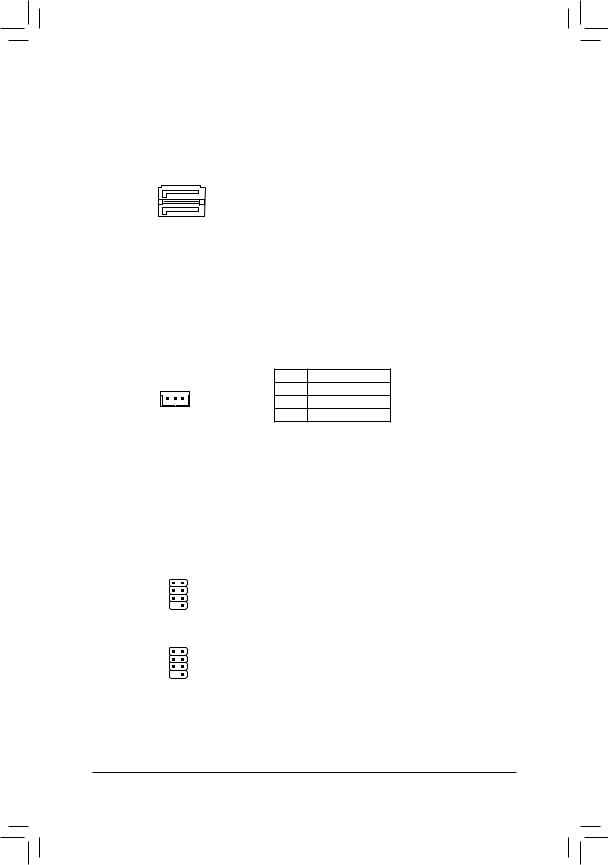
10)GSATA3 0/1 (SATA 6Gb/s Connectors, Controlled by ASMedia® ASM1061 Chip)
The SATA connectors conform to SATA 6Gb/s standard and are compatible with SATA 3Gb/s and SATA 1.5Gb/s standard. Each SATA connector supports a single SATA device.
|
|
|
Pin No. |
Definition |
|
GSATA3 |
1 |
|
1 |
GND |
|
0 |
|
||||
7 |
1 |
2 |
TXP |
||
|
|||||
|
3 |
TXN |
|||
7 |
|
1 |
|||
|
4 |
GND |
|||
|
|
|
5 |
RXN |
|
|
|
|
6 |
RXP |
|
|
|
|
7 |
GND |
11) SATA_DOM0/1 (SATA Power Headers)
The headers can provide power to SATA devices.
|
|
Pin No. |
Definition |
1 |
3 |
1 |
+5V |
2 |
GND |
||
|
|
3 |
NC |
12) SATA_SGP1/2 (SATA Detection Headers)
The headers can connect to SATA detection devices.
8 |
7 |
SATA_SGP1: |
|
SATA_SGP2: |
||
Pin No. |
Definition |
|
Pin No. |
Definition |
||
|
|
|
||||
2 |
1 |
1 |
NC |
|
1 |
NC |
SATA_SGP2 |
2 |
No Pin |
|
2 |
No Pin |
|
3 |
DATA0 |
|
3 |
DATA1 |
||
|
|
|
||||
8 |
7 |
4 |
NC |
|
4 |
NC |
5 |
NC |
|
5 |
NC |
||
|
|
|
||||
2 |
1 |
6 |
LOAD |
|
6 |
LOAD |
7 |
NC |
|
7 |
NC |
||
SATA_SGP1 |
|
|||||
8 |
CLOCK |
|
8 |
CLOCK |
||
|
|
|
||||
- 17 -
